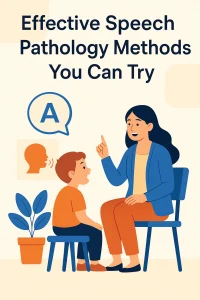Stuttering in the Workplace: What Employers Need to Know
Last Updated: June 5, 2024
Understanding stuttering in the workplace is crucial for creating an inclusive and supportive environment for all employees. Stuttering, also known as stammering, is a speech disorder that affects millions of people worldwide, yet many misconceptions and biases persist about those who stutter. Recognizing the potential of candidates who stutter and providing the right support can lead to a more diverse and innovative workforce.
In this article, we will explore what employers need to know about stuttering in the workplace. We will cover practical strategies for interviewing and supporting employees who stutter, the benefits of having a diverse team, and the legal considerations to keep in mind. Our aim is to provide you with comprehensive, actionable insights to help you create a more inclusive workplace for everyone.
Understanding Stuttering
Definition of Stuttering
Stuttering, also known as stammering, is a speech disorder characterized by disruptions in the normal flow of speech. These disruptions, often referred to as disfluencies, can include repetitions of sounds, syllables, or words, prolongations of sounds, and blocks where the person is unable to produce any sound. Stuttering can vary in severity and may be influenced by situations such as speaking in public or under stress.
Common Misconceptions About Stuttering
Understanding stuttering involves dispelling several common misconceptions that often lead to unfair biases and misunderstandings:
1. Stuttering is caused by nervousness or anxiety: One of the most prevalent myths is that stuttering is a result of being nervous or anxious. While stress can exacerbate stuttering, it is not the root cause. Stuttering is a neurological condition that affects the brain’s ability to coordinate the different components of speech.
2. People who stutter are less intelligent: There is no correlation between stuttering and intelligence. Individuals who stutter possess the same range of intelligence as those who do not. In fact, studies have shown that many people who stutter have above-average intelligence and excel in various fields.
3. Stuttering can be “cured” with willpower: Stuttering is not something that can be overcome simply by trying harder to speak fluently. While speech therapy and other interventions can help manage stuttering, it is a lifelong condition that requires understanding and support.
4. Stuttering is a sign of weakness or lack of confidence: People who stutter are often perceived as shy or lacking in confidence. However, stuttering is a speech disorder and does not reflect a person’s personality or confidence level. Many individuals who stutter are outgoing and capable of performing in high-pressure environments.
5. Stuttering is the same for everyone: Stuttering varies greatly from person to person. Some individuals may experience mild stuttering with occasional repetitions, while others may have more severe disfluencies that significantly impact their communication. Each person’s experience with stuttering is unique.
Also Read: Can Stuttering Be Overcome with Speech Therapy?
Why Employers Should Consider Candidates Who Stutter
Valuable Traits of Candidates Who Stutter
Candidates who stutter often possess a range of valuable traits that can significantly benefit the workplace. Understanding these qualities can help employers recognize the potential these individuals bring to their teams.
1. Perseverance and Resilience: People who stutter frequently develop high levels of perseverance and resilience. Overcoming daily communication challenges requires continuous effort and determination, qualities that translate into a strong work ethic and the ability to tackle difficult tasks without giving up.
2. Empathy and Listening Skills: Stuttering individuals often become exceptional listeners and empathetic communicators. Their own experiences with communication difficulties make them more attuned to others’ needs and more patient in conversations. This can enhance team dynamics and improve customer interactions.
3. Problem-Solving Abilities: Living with a stutter requires creative problem-solving skills to navigate various speaking situations. This adaptability can be a significant asset in the workplace, where innovative solutions and quick thinking are highly valued.
4. Attention to Detail: To compensate for their speech difficulties, many people who stutter pay extra attention to the content and clarity of their communication. This meticulous approach can lead to high-quality work and thoroughness in tasks.
5. Strong Work Ethic: Aware that their speech might be unfairly judged, people who stutter often strive to excel in their roles, demonstrating a strong commitment to their job responsibilities. This dedication can lead to higher productivity and a positive impact on the overall work environment.
Read more: 8 Effective Tips to Overcome Stuttering During Presentations
Diverse Perspectives and Benefits to the Workplace
Hiring candidates who stutter not only brings individual strengths but also enriches the workplace with diverse perspectives and benefits.
1. Promoting Inclusivity and Diversity: Including employees who stutter fosters a culture of inclusivity and diversity. This not only improves the organization’s image but also enhances the creativity and problem-solving capabilities of the team by incorporating different viewpoints and experiences.
2. Enhancing Team Dynamics: Employees who stutter often excel in collaborative settings. Their strong listening skills and empathy contribute to a supportive and cohesive team environment where all members feel valued and heard.
3. Building a Positive Reputation: Organizations that support and value employees with stuttering gain a positive reputation for inclusivity and fairness. This can attract top talent who are looking for a workplace that respects and supports diversity.
4. Meeting Corporate Social Responsibility Goals: By providing opportunities for people who stutter, companies can align with their corporate social responsibility goals. This demonstrates a commitment to equality and can improve relationships with stakeholders and the community.
5. Improving Customer Relations: Employees who stutter often bring unique insights into effective communication, particularly in dealing with customers. Their ability to empathize and listen carefully can lead to better customer service and stronger client relationships.
Best Practices for Interviewing Candidates Who Stutter
When interviewing candidates who stutter, it’s essential to create a supportive and understanding environment that allows them to showcase their true abilities. Here are some best practices to ensure a fair and effective interview process.
Active Listening During Interviews
Active listening is crucial when interviewing candidates who stutter. It involves fully concentrating on what the candidate is saying rather than how they are saying it. Here are some tips:
- Maintain Eye Contact: Show that you are engaged and interested in the conversation by maintaining natural eye contact. This helps the candidate feel respected and valued.
- Be Patient: Allow the candidate to speak at their own pace without interruptions. Avoid finishing their sentences or guessing words they might struggle with. This patience can help reduce pressure and create a more comfortable atmosphere.
- Focus on Content: Pay attention to the content of their responses rather than their speech disfluencies. This will help you evaluate their qualifications and suitability for the role more accurately.
Learn more about on Understanding Stuttering in Young Children: A Guide for Parents
Avoiding Assumptions About Stuttering and Job Performance
It’s important to avoid making assumptions about a candidate’s abilities based on their stuttering. Here are some ways to ensure a fair assessment:
- Assess Relevant Skills: Focus on the skills and experiences that are directly relevant to the job. Stuttering does not impact a person’s intelligence or capability to perform tasks.
- Ask Open-Ended Questions: Encourage the candidate to elaborate on their experiences and qualifications. This approach allows them to provide comprehensive answers without feeling rushed.
- Consider Accommodations: If the role involves a lot of verbal communication, discuss any accommodations or support that might help the candidate perform effectively. This shows that you are willing to work with them to ensure their success.
Respectful Communication Strategies
Respectful communication is key to making candidates who stutter feel comfortable and valued. Here are some strategies:
- Acknowledge Their Disclosure: If a candidate mentions their stuttering, acknowledge it politely. For example, you could say, “Thank you for sharing that with me. Let’s focus on your skills and experiences.”
- Avoid Patronizing Remarks: Refrain from making comments like “Just relax” or “Take your time,” as these can be perceived as patronizing. Instead, maintain a normal conversational tone and pace.
- Provide Alternatives: If you sense that a telephonic interview might be challenging, offer alternatives such as video interviews or in-person meetings. This flexibility can help the candidate feel more at ease.
Creating a Supportive Workplace Environment
To ensure employees who stutter can thrive and contribute effectively, it’s vital to create a supportive and inclusive workplace environment. Here are key strategies to promote inclusivity, offer flexible communication channels, and provide training and awareness for team members.
Promoting Inclusivity in the Workplace
Inclusivity starts with recognizing and valuing the diverse abilities and experiences of all employees. Here are ways to foster an inclusive workplace:
- Encourage Open Communication:
- Create an environment where employees feel safe to express their needs and concerns. Encourage open dialogues about stuttering and other speech disorders to reduce stigma and increase understanding.
- Inclusive Policies:
- Develop and implement workplace policies that promote equality and inclusivity. Ensure that these policies are well-communicated and understood by all employees.
- Celebrate Diversity:
- Recognize and celebrate the diverse backgrounds and abilities of your workforce. Highlighting stories of employees who stutter can help normalize the condition and promote a culture of acceptance.
- Support Networks:
- Establish support networks or employee resource groups for individuals who stutter. These groups can provide a sense of community and offer mutual support.
Flexible Communication Channels
Providing flexible communication options can significantly enhance the comfort and productivity of employees who stutter. Here are some practical suggestions:
- Alternative Communication Methods:
- Offer alternatives to verbal communication, such as email, instant messaging, or written reports. This allows employees to choose the method they are most comfortable with.
- Technology Solutions:
- Utilize technology to facilitate communication. Tools like speech-to-text software can help employees who stutter communicate more effectively.
- Accommodate Preferences:
- Be open to accommodating individual preferences for meetings and presentations. For example, allow employees to use visual aids or provide written summaries of their points.
- Flexible Meeting Formats:
- Implement flexible meeting formats that do not rely solely on verbal participation. Encourage the use of collaborative tools where ideas can be shared in written form.
Training and Awareness for Team Members
Educating your team about stuttering is crucial for building empathy and fostering a supportive environment. Here are steps to achieve this:
- Stuttering Awareness Training:
- Provide training sessions focused on understanding stuttering. Include information about what stuttering is, common misconceptions, and how to support colleagues who stutter.
- Communication Skills Workshops:
- Offer workshops that teach active listening and effective communication skills. Emphasize the importance of focusing on the content of communication rather than the delivery.
- Promote Empathy:
- Encourage team members to practice empathy and patience in their interactions. Highlight the importance of allowing colleagues who stutter to speak at their own pace without interruptions.
- Leadership Involvement:
- Ensure that leadership is involved in promoting and modeling inclusive behaviors. Leaders should be trained to recognize and support the needs of employees who stutter.
Accommodating Employees Who Stutter
To ensure employees who stutter can succeed and feel supported in their roles, employers should consider job role flexibility and provide appropriate resources and support. Here’s how to achieve this effectively.
Job Role Flexibility and Adaptations
Providing flexibility in job roles can significantly enhance the comfort and productivity of employees who stutter. Here are some ways to adapt to job roles:
- Assess Role Requirements:
- Evaluate the communication demands of the job role. If a role requires frequent verbal communication, consider ways to adapt these requirements or offer support to make the role more accessible.
- Flexible Task Assignments:
- Assign tasks based on individual strengths and preferences. For example, employees who are more comfortable with written communication can take on roles that primarily involve emails, reports, and documentation.
- Alternative Communication Methods:
- Implement alternative methods for communication, such as written reports, emails, or instant messaging. This allows employees who stutter to communicate effectively without undue stress.
- Supportive Technology:
- Use technology to facilitate communication. Tools like speech-to-text software can help employees who stutter perform their duties more efficiently.
- Adjust Meeting Formats:
- Adapt meeting formats to be more inclusive. Allow employees to provide input through written notes or pre-recorded messages if they are more comfortable doing so.
Providing Resources and Support
Offering the right resources and support is crucial in helping employees who stutter thrive in their roles. Here are some ways to provide this support:
- Access to Speech Therapy:
- Provide access to professional speech therapy services. This can help employees manage their stuttering and improve their communication skills over time.
- Workshops and Training:
- Organize workshops and training sessions focused on communication skills, stress management, and confidence building. This can benefit all employees, not just those who stutter.
- Peer Support Groups:
- Create or support peer groups where employees who stutter can share their experiences and strategies. This can foster a sense of community and mutual support.
- Mentorship Programs:
- Establish mentorship programs where experienced employees can provide guidance and support to those who stutter. This can help build confidence and professional skills.
- Regular Feedback and Check-ins:
- Schedule regular feedback sessions and check-ins to understand the needs and concerns of employees who stutter. This helps in making timely adjustments and providing necessary support.
- Encouraging Open Communication:
- Foster an environment where employees feel comfortable discussing their needs and seeking help. Encourage open dialogues about stuttering and other speech disorders.
Common Accommodations for Employees Who Stutter
| Accommodation | Description |
|---|---|
| Flexible Communication | Use emails, instant messaging, or written reports as alternatives to verbal communication. |
| Supportive Technology | Provide tools like speech-to-text software to aid communication and improve workflow efficiency. |
| Adjusted Meeting Formats | Allow employees to provide input through written notes or pre-recorded messages, reducing the need for real-time verbal responses. |
| Access to Speech Therapy | Offer professional speech therapy services as part of employee benefits to help employees manage their stuttering. |
| Regular Feedback Sessions | Schedule regular check-ins to address any concerns, provide support, and discuss any necessary accommodations. |
Addressing Legal Considerations
Understanding the Rights of Individuals Who Stutter
When hiring and supporting employees who stutter, it’s crucial to understand their legal rights to ensure compliance with anti-discrimination laws and promote a fair workplace.
- Disability Rights:
- In many jurisdictions, stuttering is recognized as a disability under laws such as the Americans with Disabilities Act (ADA) in the United States. This means that individuals who stutter are entitled to reasonable accommodations to help them perform their jobs effectively.
- Reasonable Accommodations:
- Employers are required to provide reasonable accommodations for employees who stutter. This can include adjustments like flexible communication methods, modified workspaces, and access to speech therapy. The aim is to enable the employee to perform their job to the best of their ability without undue hardship on the employer.
- Non-Discrimination:
- It is illegal to discriminate against individuals who stutter in hiring, promotion, job assignment, termination, and other aspects of employment. This includes making biased assumptions about their abilities based on their speech.
- Confidentiality:
- Employers must maintain the confidentiality of any medical information related to an employee’s stuttering. This information should only be disclosed on a need-to-know basis to ensure appropriate accommodations.
Ensuring Fair and Unbiased Hiring Practices
Creating a fair and unbiased hiring process is essential for attracting and retaining talented employees who stutter. Here are some strategies to achieve this:
- Inclusive Job Descriptions:
- Write job descriptions that focus on essential skills and qualifications without unnecessary emphasis on verbal communication unless it is a critical part of the role. Highlight your commitment to inclusivity and accommodations.
- Bias-Free Interviews:
- Train hiring managers to conduct interviews that focus on the candidate’s skills and experiences rather than their speech. Avoid making assumptions about their abilities based on their stuttering.
- Structured Interview Process:
- Use a structured interview process with standardized questions for all candidates. This helps ensure that all applicants are evaluated based on the same criteria, reducing the potential for bias.
- Accommodations During Interviews:
- Offer accommodations during the interview process, such as allowing written responses or providing extra time for candidates who stutter. This demonstrates your commitment to inclusivity and ensures that candidates can present their qualifications effectively.
- Feedback and Improvement:
- Continuously seek feedback on your hiring practices from employees and applicants. Use this feedback to make improvements and ensure that your process remains fair and inclusive.
Key Legal Considerations for Employers
| Legal Requirement | Description |
|---|---|
| Non-Discrimination | Ensure no bias in hiring, promotion, or job assignments based on stuttering. |
| Reasonable Accommodations | Provide necessary adjustments, such as flexible communication methods and supportive technology, to help employees perform their jobs effectively. |
| Confidentiality | Maintain the privacy of medical information related to stuttering, disclosing it only on a need-to-know basis to ensure appropriate accommodations. |
| Fair Interview Practices | Use standardized questions for all candidates and avoid making assumptions about job performance based on speech disfluencies. |
Conclusion
Creating a supportive and inclusive workplace for employees who stutter not only helps the individuals but also improves the overall work environment. Understanding stuttering is essential; it’s a speech disorder that disrupts normal speech flow, not a sign of nervousness or low intelligence. People who stutter often have valuable traits like perseverance, empathy, strong listening skills, and problem-solving abilities. To ensure a fair interview process, engage in active listening, avoid making assumptions about their performance, and communicate respectfully. Promoting inclusivity, offering flexible communication options, and providing training and awareness are key to creating a supportive environment.
Employers have a crucial role in supporting candidates who stutter. By understanding their unique needs and offering the right accommodations, you can unlock their full potential and create a more diverse and dynamic workplace. Embrace the opportunity to support employees who stutter and see the positive impact on your team. For more insights and resources on fostering an inclusive workplace, visit Wellness Hub. At Wellness Hub, we are committed to helping you create a welcoming and productive work environment for everyone. Thank you for learning about this important topic and for your dedication to inclusivity.
Frequently Asked Questions:
1. What is stuttering and how does it affect workplace communication?
Stuttering is a speech disorder characterized by disruptions in the flow of speech, such as repetitions, prolongations, and blocks. In the workplace, it can affect communication, but with the right support and accommodations, individuals who stutter can effectively perform their job responsibilities.
2. Why should employers consider hiring candidates who stutter?
Candidates who stutter often possess valuable traits such as perseverance, empathy, strong listening skills, and problem-solving abilities. Their unique perspectives can enhance team dynamics and contribute to a more inclusive and innovative workplace.
3. How can employers create a supportive environment for employees who stutter?
Employers can create a supportive environment by promoting inclusivity, offering flexible communication channels, providing training and awareness for team members, and ensuring job roles are adaptable to meet the needs of employees who stutter.
4. What are some best practices for interviewing candidates who stutter?
Best practices include engaging in active listening, avoiding assumptions about stuttering and job performance, and using respectful communication strategies. Providing alternative communication methods, like written responses, can also be helpful.
5. What legal considerations should employers be aware of regarding employees who stutter?
Employers should understand the rights of individuals who stutter under laws such as the Americans with Disabilities Act (ADA). This includes providing reasonable accommodations and ensuring non-discriminatory hiring practices.
6. How can job roles be adapted to support employees who stutter?
Job roles can be adapted by offering flexible communication methods, using supportive technology like speech-to-text software, and assigning tasks that match the strengths and preferences of the employee. Regular feedback and check-ins can also help address any concerns.
7. What resources can employers provide to support employees who stutter?
Employers can provide access to speech therapy, organize communication skills workshops, create peer support groups, and establish mentorship programs. These resources help employees manage their stuttering and enhance their professional development.
8. How does fostering an inclusive workplace benefit the organization?
Fostering an inclusive workplace promotes diversity, enhances team dynamics, improves customer relations, and aligns with corporate social responsibility goals. It also helps attract and retain top talent who value a supportive and inclusive work environment.
9. Can stuttering be managed effectively in a professional setting?
Yes, with the right support and accommodations, stuttering can be managed effectively. Many individuals who stutter excel in professional settings when given the opportunity to utilize their strengths and receive appropriate support.
10. Where can I find more resources on supporting employees who stutter?
Visit Wellness Hub for more insights and resources on fostering an inclusive workplace. Wellness Hub provides valuable information to help employers create a welcoming and productive environment for all employees.
About the Author:
Anuradha Karanam
Speech-language pathologist (7+ years of experience)
Anuradha Karanam is a skilled speech-language pathologist with over 6 years of experience. Fluent in Tamil, Telugu, Hindi, and English, she specializes in parent counseling, speech sound disorders, fluency assessment, and speech-language evaluations. Anuradha excels at working with children with developmental disorders, offering creative and effective therapy programs. Currently, at Wellness Hub, she holds a BASLP degree and is registered with the RCI (CRR No A85500). Her patience, ambition, and dedication make her a trusted expert.
Connect with Anuradha to learn more about how she can help you or your loved one find their voice.
Book your Free Consultation Today
Parent/Caregiver Info:
Client’s Details:
* Error Message









